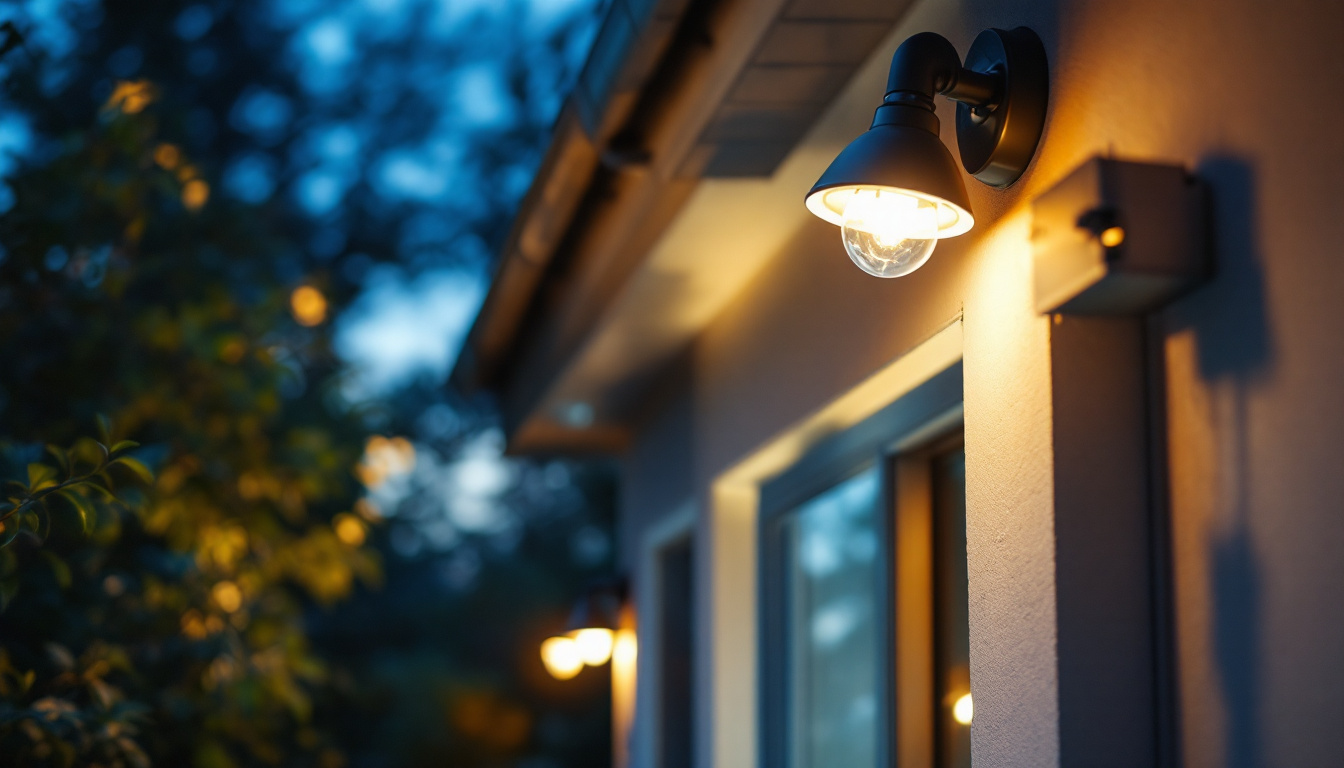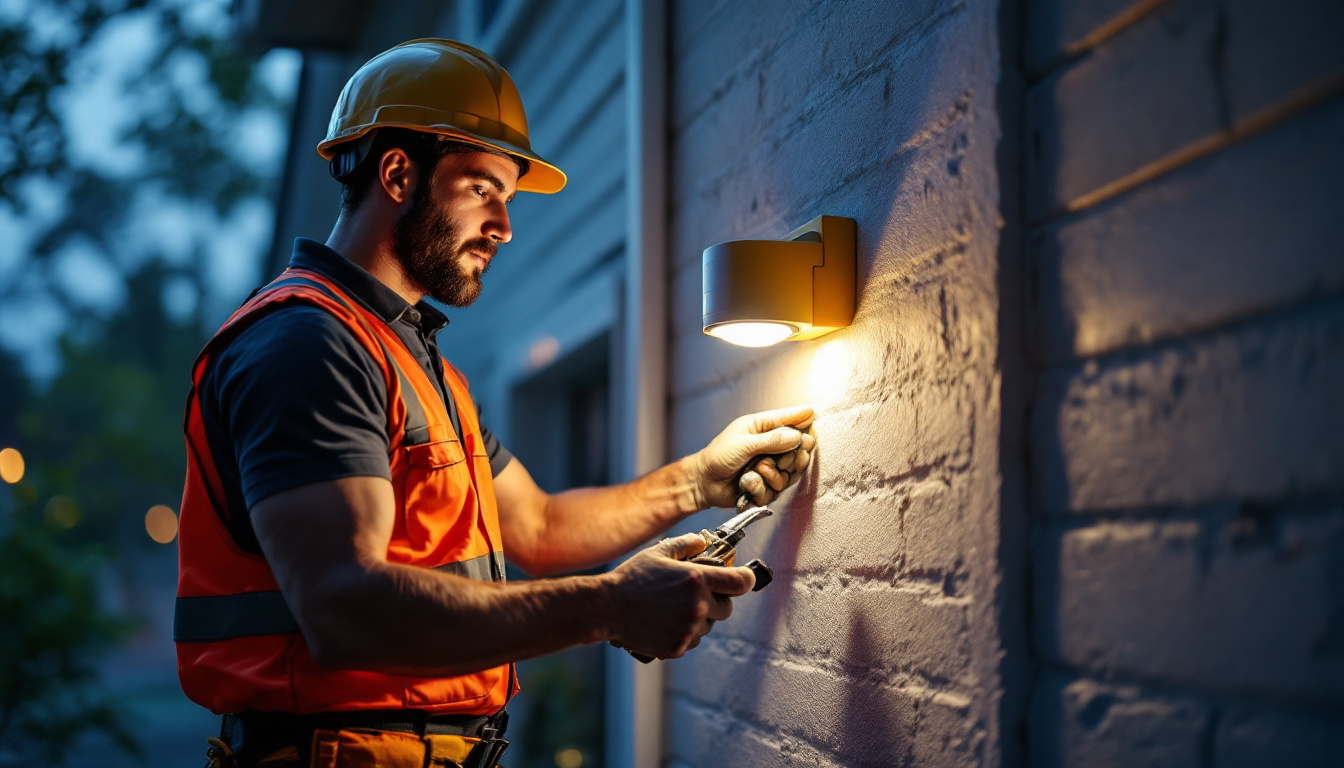
In recent years, the demand for sustainable and energy-efficient lighting solutions has surged, prompting lighting contractors to explore innovative technologies. One such advancement is the solar wall lamp, a versatile lighting fixture that not only enhances outdoor spaces but also aligns with eco-friendly practices. This article delves into the transformative impact of solar wall lamps on the work of lighting contractors, examining their benefits, installation processes, and the future of outdoor lighting.
As the world increasingly prioritizes sustainability, solar lighting solutions have emerged as a popular alternative to traditional electric lighting. Solar wall lamps harness the power of the sun, converting sunlight into energy that powers LED lights. This technology not only reduces electricity costs but also minimizes the carbon footprint associated with outdoor lighting. The advancements in solar technology have made these systems more efficient, enabling them to store energy even on cloudy days, thus ensuring consistent performance throughout the year.
One of the primary advantages of solar wall lamps is their cost-effectiveness. By eliminating the need for electrical wiring and reducing energy consumption, these lamps can significantly lower installation and operational costs. Additionally, the use of solar energy means that lighting contractors can offer clients a greener solution that aligns with modern environmental standards. With the declining prices of solar technology, the initial investment is becoming more accessible, making it an attractive option for both residential and commercial projects.
Another benefit is the ease of installation. Solar wall lamps are typically designed for straightforward setup, requiring minimal tools and expertise. This allows lighting contractors to complete projects more quickly, enhancing productivity and client satisfaction. Furthermore, solar lamps often come with built-in sensors that automatically turn the lights on at dusk and off at dawn, providing convenience and energy savings. Some models even feature motion sensors, which can help conserve energy by activating only when movement is detected, making them an ideal choice for security lighting.
Solar wall lamps are versatile and can be utilized in a variety of settings. From residential gardens and pathways to commercial properties and public parks, these fixtures provide illumination where it is needed most. For lighting contractors, this versatility opens up new opportunities for projects, allowing them to cater to a broader range of clients and applications. In urban environments, solar wall lamps can be integrated into smart city initiatives, providing sustainable lighting solutions that complement other green technologies.
Moreover, solar wall lamps can enhance safety and security in outdoor spaces. By providing adequate lighting in dark areas, they deter potential intruders and create a welcoming atmosphere for residents and visitors alike. This aspect is particularly appealing to clients looking to improve safety in their properties. Additionally, the aesthetic appeal of solar wall lamps, which come in various designs and finishes, allows them to blend seamlessly with the landscape, enhancing the overall ambiance of outdoor areas. As communities increasingly focus on creating inviting public spaces, the demand for stylish and effective solar lighting solutions continues to grow.
The installation of solar wall lamps is generally more straightforward than traditional lighting systems. Since they do not require electrical wiring, lighting contractors can save time and resources during the installation process. Understanding the key steps involved can further streamline this process.
Before installation, a thorough site assessment is essential. Lighting contractors should evaluate the area where the solar wall lamps will be installed, considering factors such as sunlight exposure, existing structures, and the desired lighting effect. This assessment helps in determining the optimal placement of the lamps to maximize solar energy absorption.
Planning also involves selecting the right type of solar wall lamp for the specific project. Contractors should consider factors like brightness, design, and features such as motion sensors or dimming capabilities. By choosing the appropriate lamp, contractors can ensure that their clients receive the best possible lighting solution. Additionally, understanding the local climate is critical; regions with prolonged cloudy seasons may benefit from solar lamps with larger battery capacities or those that can be charged via alternative methods. This foresight can prevent potential issues with insufficient lighting during darker months.
The installation process typically involves a few straightforward steps. First, the contractor should mark the desired locations for the lamps based on the site assessment. Next, they will secure the mounting brackets to the wall, ensuring they are level and stable. After that, the solar wall lamps can be attached to the brackets, followed by adjusting the angle for optimal sunlight exposure.
Finally, it is crucial to test the lamps to ensure they function correctly. This includes checking the solar panel’s alignment and verifying that the automatic sensors are operational. A successful installation not only enhances the aesthetics of the space but also provides long-lasting benefits for the client. Furthermore, educating the client about the maintenance of solar wall lamps can enhance their experience. Providing tips on keeping the solar panels clean and ensuring that surrounding foliage does not obstruct sunlight can significantly extend the lifespan and efficiency of the lighting system. Regular maintenance checks can also be scheduled to ensure that the lamps continue to perform at their best, thus maximizing the return on investment for the client.
While solar wall lamps offer numerous advantages, there are also challenges that lighting contractors must navigate. Understanding these challenges can help contractors better prepare for projects and address client concerns effectively.
One of the primary considerations when installing solar wall lamps is the local climate. Areas with limited sunlight or frequent overcast conditions may not provide sufficient energy for solar lamps to function optimally. Lighting contractors should evaluate the solar potential of the installation site and educate clients on how weather conditions can impact performance.
In regions with harsh weather conditions, such as heavy rain or snow, selecting durable and weather-resistant solar wall lamps is essential. Contractors should look for products that are specifically designed to withstand the elements, ensuring longevity and reliability. Additionally, the orientation of the solar panels can significantly influence energy absorption; therefore, positioning them to maximize exposure to sunlight is crucial. This may involve strategic placement on walls or structures that receive the most direct sunlight throughout the day, thus enhancing the overall efficiency of the solar lighting system.
Another challenge is managing client expectations regarding the performance of solar wall lamps. Clients may have misconceptions about how solar lighting works and its limitations. Lighting contractors play a vital role in educating clients about the technology, including factors that influence performance, such as battery life and charging time.
Providing clear information about maintenance requirements can also help clients understand the long-term care needed for solar wall lamps. Regular cleaning of the solar panels and ensuring that the lamps are free from obstructions will optimize their performance and lifespan. Furthermore, contractors should discuss the importance of seasonal changes, as daylight hours vary throughout the year, affecting the charging capabilities of solar lamps. By addressing these aspects, contractors can foster a more informed client base that appreciates the benefits and limitations of solar lighting, ultimately leading to greater satisfaction with their installations.
The future of solar wall lamps looks promising, with ongoing advancements in technology and design. As lighting contractors continue to adopt these solutions, several trends are likely to shape the industry.
As technology progresses, solar wall lamps are becoming increasingly sophisticated. Innovations such as smart solar lighting systems, which can be controlled via mobile apps, are gaining popularity. These systems allow users to adjust brightness levels, set timers, and monitor energy usage, providing a customizable lighting experience.
Additionally, advancements in solar panel efficiency and battery storage technology are enhancing the performance of solar wall lamps. Improved energy conversion rates mean that lamps can operate for longer periods, even in less-than-ideal conditions. Lighting contractors who stay informed about these innovations can offer clients cutting-edge solutions that meet their needs.
Another trend is the integration of solar wall lamps with smart home systems. As homeowners increasingly seek interconnected devices, lighting contractors can provide solutions that seamlessly integrate solar lighting with other smart technologies. This integration enhances convenience and allows for a more cohesive approach to home automation.
By offering solar wall lamps that can communicate with other smart devices, contractors can position themselves as forward-thinking professionals who understand the evolving needs of their clients.
Solar wall lamps are revolutionizing the way lighting contractors approach outdoor lighting projects. With their numerous benefits, including cost savings, ease of installation, and environmental sustainability, these fixtures present a compelling option for both contractors and clients alike. As technology continues to advance, the potential for solar wall lamps will only grow, paving the way for innovative solutions in the lighting industry.
By embracing solar wall lamps, lighting contractors can not only enhance their service offerings but also contribute to a more sustainable future. As the demand for eco-friendly lighting solutions increases, those who adapt to these changes will undoubtedly thrive in the evolving landscape of the lighting industry.
Ready to harness the power of solar wall lamps and elevate your lighting projects? At LumenWholesale, we provide lighting contractors with the finest spec-grade lighting products at unbeatable wholesale prices. Our selection of solar wall lamps meets the highest industry standards, ensuring you deliver reliable and high-performance lighting solutions to your clients. Take advantage of our hassle-free bulk buying options and free shipping to get premium lighting at the best value — without hidden fees or compromises. Transform your approach to outdoor lighting and contribute to a sustainable future with LumenWholesale. Wholesale Lighting at the Best Value.

Discover why purchasing architectural square linear lights in bulk from local distributors might not be the best choice.

Discover the transformative power of solar lights in garden lighting installations.

Discover how lighting contractors can enhance their business by installing security lights outdoors.

Discover the frequent pitfalls lighting contractors face when installing security lights with motion sensors.